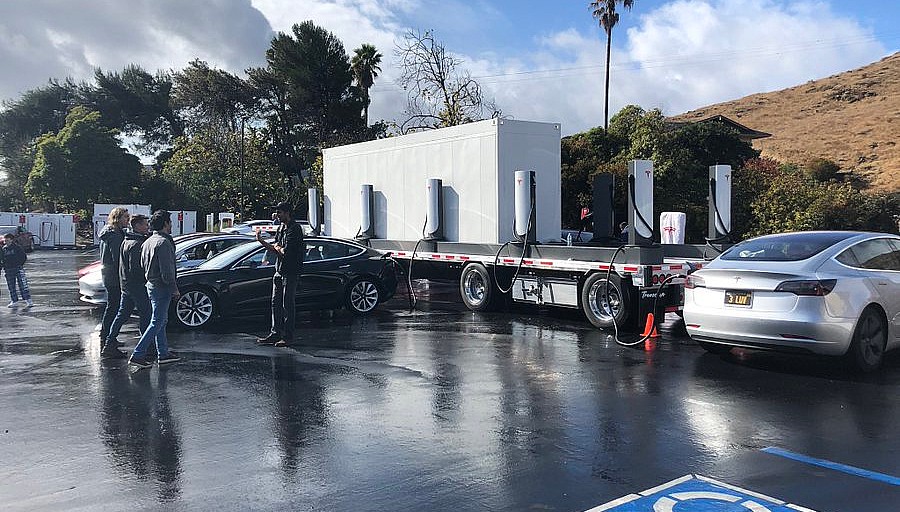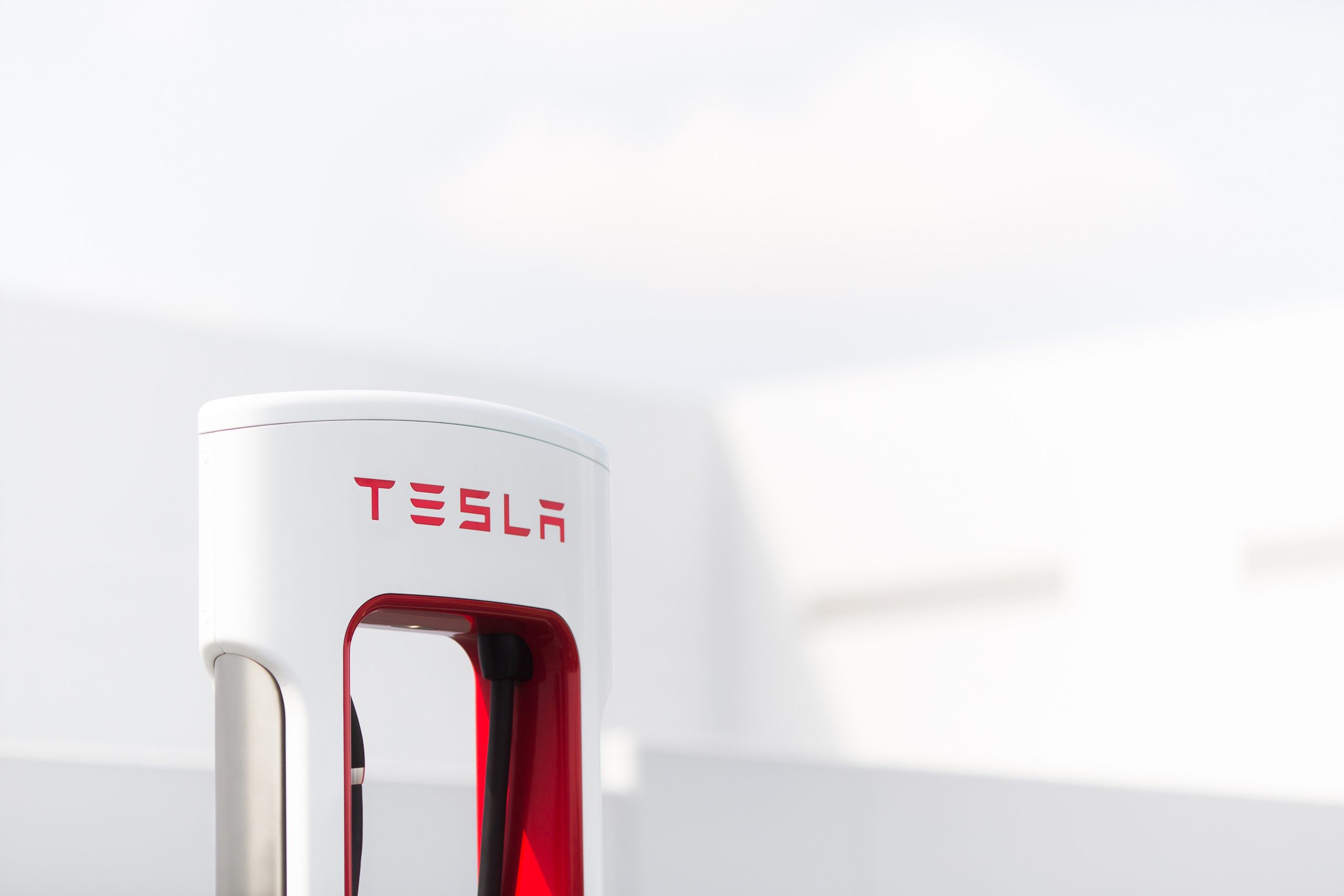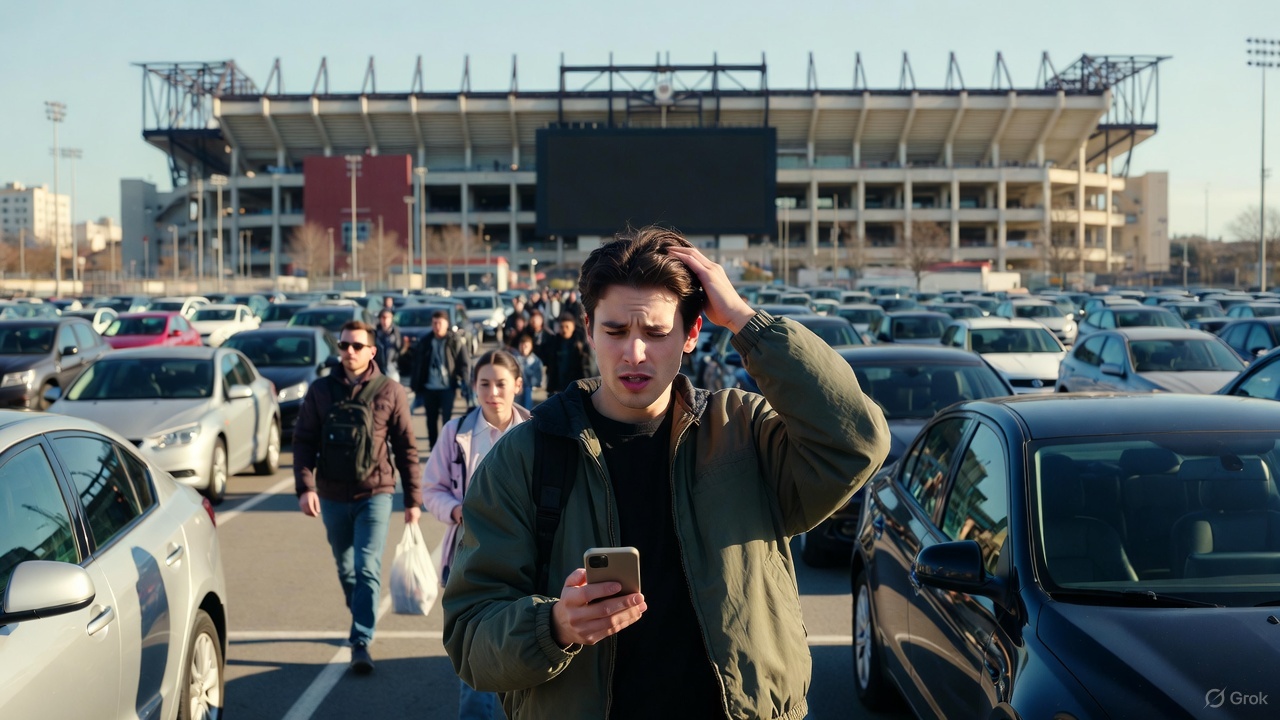

News
Tesla deploys Megapack-powered Mobile Superchargers for the holidays
Tesla may just have figured out the perfect way to bolster its charging infrastructure during the holidays, a time when more drivers are taking long trips and relying on the company’s Supercharger Network. Based on images and videos captured by the Tesla community, it appears that the electric car maker has started deploying Mobile Supercharger units that are powered by Megapack batteries, which are then installed on a trailer.
This setup allows Tesla to instantly add more charging stalls at a specific location. One of these Megapack-powered chargers was spotted in San Luis Obispo (SLO) at the Madonna Inn Supercharger. Looking at the photographs of Tesla’s setup from EV enthusiast Brian Swenson, the Megapack appears to be hooked up to eight Urban Supercharger stalls that are set up on the trailer itself.
Quite interestingly, the Mobile Supercharger stalls are reportedly capable of providing up to 125 kW of dedicated power. This makes them comparable to the previous output of Tesla’s V2 network before it was improved by the electric car maker to allow peak charge rates of up to 150 kW. Regardless, 125 kW is not inconvenient at all, especially for drivers who wish to take a coffee break in the middle of a long drive.
A video recorded by Tesla owner-enthusiast Shelly Fraval included a brief conversation with one of the electric car maker’s staff who happened to be with the Mobile Supercharger. According to the Tesla employee, the Megapack-powered Mobile Superchargers are being deployed by the company as a way to help owners during holidays such as Thanksgiving. In the Madonna Inn Supercharger, for example, wait times reached almost one hour last year during the holidays, but with the Mobile Supercharger in place, these wait times are expected to decrease to just minutes.
The deployment of Tesla’s Megapack-powered Mobile Superchargers holds a lot of potential for the company. Such solutions, after all, are perfect for events such as concerts, sports events, and even calamities such as fires and hurricanes. Even if the grid were to go down unexpectedly, Tesla would be able to deploy a mobile charging system to owners across the country. This, of course, would most certainly benefit Tesla owners all over.
Tesla’s Megapack-powered Mobile Supercharger units will likely be more and more helpful in the coming quarters, particularly as the company starts delivering its most high-volume vehicle to date: the Model Y crossover. Once that vehicle is on the market, there is a very good chance that even Tesla’s expansive Supercharger Network would be utilized to its limits just to meet the demand from Model 3 and Model Y owners. During such instances, the Megapack-powered Mobile Superchargers would definitely be an ace for the company.

Investor's Corner
SpaceX IPO is coming, CEO Elon Musk confirms
However, it appears Musk is ready for SpaceX to go public, as Ars Technica Senior Space Editor Eric Berger wrote an op-ed that indicated he thought SpaceX would go public soon. Musk replied, basically confirming it.

Elon Musk confirmed through a post on X that a SpaceX initial public offering (IPO) is on the way after hinting at it several times earlier this year.
It also comes one day after Bloomberg reported that SpaceX was aiming for a valuation of $1.5 trillion, adding that it wanted to raise $30 billion.
Musk has been transparent for most of the year that he wanted to try to figure out a way to get Tesla shareholders to invest in SpaceX, giving them access to the stock.
He has also recognized the issues of having a public stock, like litigation exposure, quarterly reporting pressures, and other inconveniences.
However, it appears Musk is ready for SpaceX to go public, as Ars Technica Senior Space Editor Eric Berger wrote an op-ed that indicated he thought SpaceX would go public soon.
Musk replied, basically confirming it:
As usual, Eric is accurate
— Elon Musk (@elonmusk) December 10, 2025
Berger believes the IPO would help support the need for $30 billion or more in capital needed to fund AI integration projects, such as space-based data centers and lunar satellite factories. Musk confirmed recently that SpaceX “will be doing” data centers in orbit.
AI appears to be a “key part” of SpaceX getting to Musk, Berger also wrote. When writing about whether or not Optimus is a viable project and product for the company, he says that none of that matters. Musk thinks it is, and that’s all that matters.
It seems like Musk has certainly mulled something this big for a very long time, and the idea of taking SpaceX public is not just likely; it is necessary for the company to get to Mars.
The details of when SpaceX will finally hit that public status are not known. Many of the reports that came out over the past few days indicate it would happen in 2026, so sooner rather than later.
But there are a lot of things on Musk’s plate early next year, especially with Cybercab production, the potential launch of Unsupervised Full Self-Driving, and the Roadster unveiling, all planned for Q1.
News
Tesla adds 15th automaker to Supercharger access in 2025

Tesla has added the 15th automaker to the growing list of companies whose EVs can utilize the Supercharger Network this year, as BMW is the latest company to gain access to the largest charging infrastructure in the world.
BMW became the 15th company in 2025 to gain Tesla Supercharger access, after the company confirmed to its EV owners that they could use any of the more than 25,000 Supercharging stalls in North America.
Welcome @BMW owners.
Download the Tesla app to charge → https://t.co/vnu0NHA7Ab
— Tesla Charging (@TeslaCharging) December 10, 2025
Newer BMW all-electric cars, like the i4, i5, i7, and iX, are able to utilize Tesla’s V3 and V4 Superchargers. These are the exact model years, via the BMW Blog:
- i4: 2022-2026 model years
- i5: 2024-2025 model years
- 2026 i5 (eDrive40 and xDrive40) after software update in Spring 2026
- i7: 2023-2026 model years
- iX: 2022-2025 model years
- 2026 iX (all versions) after software update in Spring 2026
With the expansion of the companies that gained access in 2025 to the Tesla Supercharger Network, a vast majority of non-Tesla EVs are able to use the charging stalls to gain range in their cars.
So far in 2025, Tesla has enabled Supercharger access to:
- Audi
- BMW
- Genesis
- Honda
- Hyundai
- Jaguar Land Rover
- Kia
- Lucid
- Mercedes-Benz
- Nissan
- Polestar
- Subaru
- Toyota
- Volkswagen
- Volvo
Drivers with BMW EVs who wish to charge at Tesla Superchargers must use an NACS-to-CCS1 adapter. In Q2 2026, BMW plans to release its official adapter, but there are third-party options available in the meantime.
They will also have to use the Tesla App to enable Supercharging access to determine rates and availability. It is a relatively seamless process.
News
Tesla adds new feature that will be great for crowded parking situations
This is the most recent iteration of the app and was priming owners for the slowly-released Holiday Update.

Tesla has added a new feature that will be great for crowded parking lots, congested parking garages, or other confusing times when you cannot seem to pinpoint where your car went.
Tesla has added a new Vehicle Locator feature to the Tesla App with App Update v4.51.5.
This is the most recent iteration of the app and was priming owners for the slowly-released Holiday Update.
While there are several new features, which we will reveal later in this article, perhaps one of the coolest is that of the Vehicle Locator, which will now point you in the direction of your car using a directional arrow on the home screen. This is similar to what Apple uses to find devices:
Interesting. The location arrow in the Tesla app now points to your car when you’re nearby. pic.twitter.com/b0yjmwwzxN
— Whole Mars Catalog (@wholemars) December 7, 2025
In real time, the arrow gives an accurate depiction of which direction you should walk in to find your car. This seems extremely helpful in large parking lots or unfamiliar shopping centers.
Getting to your car after a sporting event is an event all in itself; this feature will undoubtedly help with it:
The nice little touch that Tesla have put in the app – continuous tracking of your vehicle location relative to you.
There’s people reporting dizziness testing this.
To those I say… try spinning your phone instead. 😉 pic.twitter.com/BAYmJ3mzzD
— Some UK Tesla Guy (UnSupervised…) (@SomeUKTeslaGuy) December 8, 2025
Tesla’s previous app versions revealed the address at which you could locate your car, which was great if you parked on the street in a city setting. It was also possible to use the map within the app to locate your car.
However, this new feature gives a more definitive location for your car and helps with the navigation to it, instead of potentially walking randomly.
It also reveals the distance you are from your car, which is a big plus.
Along with this new addition, Tesla added Photobooth features, Dog Mode Live Activity, Custom Wraps and Tints for Colorizer, and Dashcam Clip details.
🚨 Tesla App v4.51.5 looks to be preparing for the Holiday Update pic.twitter.com/ztts8poV82
— TESLARATI (@Teslarati) December 8, 2025
All in all, this App update was pretty robust.








